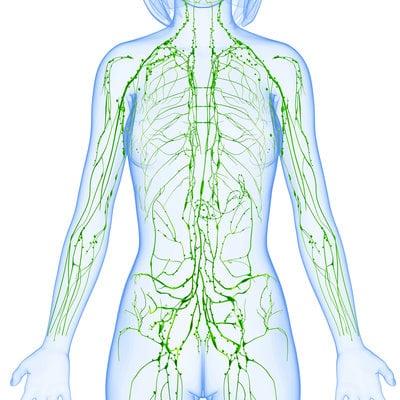Lymphedema Facts
What is lymphedema?
Lymphedema is swelling that develops due to the abnormal collection of fluid beneath the skin, most commonly in an arm or leg. This can occur when lymph nodes are removed or damaged during cancer treatment. It can also be the result of other trauma, and can be an inherited condition in those born with a deficiency in their lymphatic system.
What is the lymphatic system?

Your lymphatic system, which is part of your immune system, is a specialized network made up of lymphatic channels and lymph nodes. Much as the circulatory system carries blood throughout the body, the lymphatic system carries lymphatic fluid, a clear liquid that contains infection-fighting white blood cells. If you have ever scraped your knee and noticed the seepage of clear liquid through the wound, then you saw lymphatic fluid oozing from the tissues.
The lymph nodes are small structures that filter the fluid, which carries various debris and impurities collected from the tissues on its travels through the body. When damage occurs to the lymph nodes or lymphatic channels, the lymphatic fluid has nowhere to go and begins to collect like water behind a dam. Because lymphatic fluid is rich in proteins and contains salts, it attracts additional fluid and the localized swelling becomes more severe.
Are you at risk for lymphedema?
Lymphedema is common in the developed world and is most commonly caused by an injury or disruption of the lymphatic system. For example, surgery, chemotherapy and/or radiation therapy may injure the lymphatic system. Lymphedema often happens following surgery that involves removal of lymph nodes such as an axillary lymph node dissection or after radiation therapy. It can appear weeks, months or even years after the surgery. It is not always clear why some people develop swelling while others do not.
What are the signs and symptoms of lymphedema?
In its early stages, lymphedema may be a subtle change to the way your body looks or feels. An increase as small as three-fourths of an inch to the circumference of your upper arm may be an indicator of lymphedema. Since early detection gives you a better chance of successful treatment, it is important to remain vigilant.
Symptoms of lymphedema may include:
-
The limb or affected area feels heavy or full
-
Tightness or decreased flexibility in the nearby joints
-
Slight puffiness or swelling in the limb or nearby tissue
-
A lasting ‘dent’ in the skin when you press it with your finger
-
Veins, tendons or knuckles become harder to see
-
Skin that was wrinkled becomes smooth
-
Clothes or undergarments become too small
-
Swelling that makes removing watches and rings more difficult
-
Changes in skin texture, such as swelling, hardening or redness